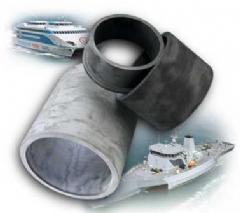 Add My Company
Add My Company
Sign In
Freeze Fitting Rudder Bearings
02-08-2007

As merchant ships get larger and faster there are increasing demands on steering systems and rudder bearing reliability, new freeze fitting methods are able to offer many advantages.
Although not normally considered when owners specify the makers list, there is a growing realisation that a malfunctioning rudder can cripple a vessel, with costly repairs and loss of sea time.
The critical requirement with rudder bearings relates to the bush retention in the rudder housing. If the bearing turns or jams on the rudder shaft, this can cause the bearing to move out of the housing if the retaining plate shears.
Orkot Marine Bearings, a member company of Trelleborg Sealing Solutions Ltd, has developed several advanced methods of fitting and retaining its bearings and devised sophisticated design programs that calculate the hoop stress required to retain the bearings under all conditions including Ice class vessels.
Fitting techniques
The three normal techniques of fitting rudder bearings are press fitting, resin chocking and freeze fitting. The first of these requires a large force to press the bearing into the housing (at least 42 tonnes for a large container ship's 1200mm diameter bush) and can damage a bearing that is not in line when fitting.
Resin chocking is favoured by some shipbuilders as upper and lower pintle housings do not have to be accurately aligned during machining. Builders can either bore the housings in-line after welding, which is expensive and time consuming, or pre-machine them before assembly. Since this cannot guarantee alignment, bearings are assembled with a gap to the housing and aligned before pouring the chocking compound, which cures to form the housing and makes bearing removal on refit difficult by requiring it to be cut out.
Freeze fitting can be used most effectively with non-metallic bearings such as composite materials. Bearings can be frozen in solid carbon dioxide but liquid nitrogen (LN) is recommended to achieve the required diameter reduction with a composite bearing. The two methods of freezing using LN are vapour freezing and the more standard full immersion, which is where Orkot has developed some new thinking.
First, the vapour system uses the bearing as the freezing tank (method 1). Wooden end plates seal the bearing and LN is introduced using a thin lance, with an insulating blanket reducing heat transfer. This method reduces the amount of LN used and is safe as the operator is not in contact with it. However, this method is very slow because it takes a long time to reduce the bearing diameter and generate enough clearance for fitting.
Full immersion
Fully immersing the bearing in LN is more usual and can be done using a couple of existing container methods.
The method is to make a container able to withstand -197°C and accommodate the bearing. LN is poured in to cover the bearing and must be topped up to maintain this level since it will initially 'bail' off as the temperature reduces. When the LN reduces to a 'simmer' the bearing must be raised to check its diameter and make sure that there is sufficient clearance for fitting.
The bearing is then inserted into the rudder housing or into a machined metal sleeve which is then resin chocked into the rudder housing. While this method reduces refit problems it is costly and difficult to machine accurately. Another downside is a larger and more expensive rudder housing is required.
New method
The new LN freeze-fit method developed by Orkot uses a 3mm thin wall stainless steel housing rolled and welded without machining and offers an array of advanced benefits. The rolled sleeve is joined with an external axial stainless steel strip that is also used as the anti-rotation key after fitting the sleeve and bearing.
This sleeve is 20mm shorter than the bearing to reduce seawater corrosion after fitting to the vessel. It is re-rolled after
For more information on Freeze Fitting Rudder Bearings talk to Trelleborg
Enquire Now
List your company on FindTheNeedle.
